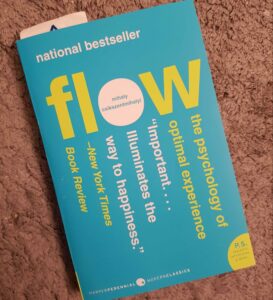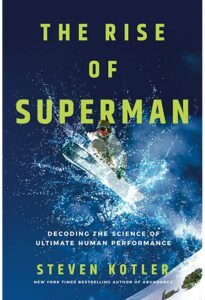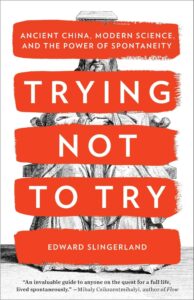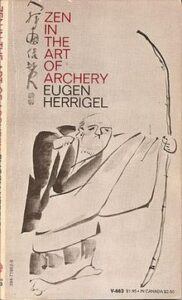A few years ago, I offered a series of workshops with a dancer called Marina Collard. It was very inspiring for me to bring awareness to simple gestures for hours at a time. Every time Marina moved, she looked like water being poured – always carving an elegant balance between releasing tension, counterbalancing and moving.
Dancers like Marina are able to cultivate a mode of effortless, harmonious action without muscling or over-thinking. In other words, they enter into a ‘flow state’.
I love this definition of flow states from Edward Slingerhand:
“”No trying” or “no doing”… is not all about dull inaction. In fact, it refers to the dynamic, effortless and unconscious state of mind of a person who is optimally active and effective.”
Ever since my early studies of Zen and Buddhism I’ve been fascinated by the idea of ‘non-doing’, or as Slingerhand refers to it ‘trying not to try’. In this blog I’m going to review four books that have greatly inspired me along the way.
As I review these four books about flow states, we’ll explore:
• What flow states are
• How we can each work to trigger flow states.
• What we can learn from these writings about becoming better bodyworkers.
ONE: Flow: The Psychology of Optimal Experience
By Mihayl Csikszentmihalyi

In 2014 I discovered this influential book, which looks at sports people, meditators, and people writing amazing essays, or otherwise amazing outputs.
It was one of the first, ground-breaking studies of flow states, and Csikszentmihalyi begins by explaining a flow state as:
“You know that what you need to do is possible to do, even though it is difficult, and sense of time disappears. You forget yourself. You feel part of something larger.”
Consistently people report that when they’re in flow states, their sense of time shifts, and they become far more effective.
We can understand this by looking at what happens when we’re learning to ride a bike. When you first start to ride, there are a huge amount of new skills to learn, and initially you have to concentrate in order to do them all while your bike is wobbling beneath you. Then, at a certain stage the learned motor patterns disappear and you achieve riding a bike without any focus.
In flow states we’re efficiently processing the world. In the same way as riding a bike without thinking, we don’t need to pay attention to unnecessary things within or around us. This gives us more choices and makes us infinitely more effective.
TWO: The Rise of Superman: Decoding the Science of Ultimate Human Performance.
By Stephen Kotler

This has a terrible name, but it is a great book. It develops Csikszentmihalyi’s work and takes a more athletic exploration of the modern science of flow states, offering an incredibly rich take.
Kotler explores what it takes to achieve incredible feats – such as the person who did the first double somersault instead of a single one, or the first people who slack-lined across great canyons.
He lays out three external triggers for flow states, which are available for all of us:
1 Risk – firstly, we’re more likely to achieve flow if there is an element of risk. It has to mean something – the high consequence drives greater focus. This looks different for each of us. For me, as a bodyworker, the risk of not being able to actually help a client relieve their pain or suffering is something I take very seriously. My clients are paying me and trusting me to help them suffer less, and this makes me incredibly focused in my client work.
2 A rich / novel environment – novelty, unpredictability and complexity add to our focus. We can each work to cultivate this by actively noticing new things in the environment around us.
3 Deep embodiment – This was my main takeaway from this book. Although the felt sense of the body can disappear during flow states, it doesn’t come from a dissociative state, but rather from a profound, unconscious availability of the body.
THREE: Trying Not to Try: Ancient China, Modern Science and the Power of Spontaneity
Edward Slingerhand.

Some criticise the flow states model as overly focused on individual performance. “Trying Not to Try” expands the conversation, revisiting Chinese philosophies from 500 – 200 BC whilst referencing modern science, including a broader focus on virtue, ethics, community and leadership.
FOUR: Zen in The Art of Archery
Eugen Herrigel

This book was my first entry into the world of Zen and Daosim. I read it many years ago when I was studying Zen Shiatsu. It was written in the 1960s by a westerner embedded in Japan, learning how to do archery by, as Herrigel says, ‘letting the arrow fire itself’. It is full of rich and evocative language”
“The archer ceases to be conscious of himself as the one who is engaged in hitting the bull’s eye which confronts him. This state of unconsciousness is realized only when, completely empty and rid of the self, he becomes one with the perfecting of his technical skill”.
This book is not without its critics and Herrigel may have been a little free with his interpretations, but still it offers a beautiful story of trying too hard and going down blind alleys, then returning to effortlessness – a state of being in harmony with the bow and arrow.
It opened up a whole new world for me, and I continue to believe that this is the best book to read if you want to understand biodynamic craniosacral therapy.
And finally…
I don’t have a book to recommend here, but I do want to mention that one of my strongest teachers has been Franklyn Sills, the early trailblazer in the development of a biodynamic understanding and approach to craniosacral therapy.
He has an amazing mind and a warm heart. He studied the Tao Te Ching, a famous classic Chinese text. He wove Buddhism and the idea of non-doing, and effortless action into his work.
There was real joy in my time as a tutor at the Karuna Institute hearing Franklyn make links between biodynamic craniosacral therapy and his study of Taoism. There was a clear focus on change emerging from within facilitated by the presence of another, and I’ve enjoyed reviewing these ideas as I’ve been teaching the first semester of the Art of Touch, my new BCST training.
If you’d like to explore more of these concepts as a body worker, I invite you to look at the curriculum of my new Art of Touch training here.
We have new cohorts starting in London and Galway, Ireland later this year and it is suitable for existing health professionals considering adding a new modality to their work as well as individuals wanting to start a career in an exciting and evolving therapy.
Explore The Art of Touch 2023 LONDON here >>
Explore The Art of Touch 2024 GALWAY here >>
Upcoming Trainings:
Biodynamic Craniosacral Therapy (BCST):
The Art of Touch 2 Year Training: London – starts Oct 2023
The Art of Touch 2 Year Training: Galway – starts Mar 2024
Tension and Trauma Releasing Exercises (TRE®):
TRE Certification Training ONLINE:
Module 1 Online: 8-9 Jul
Module 2 Online: 13-14 Apr, 20-21 Sep
Module 3 Online: 15-16 Apr, 28-29 Aug, 11-12 Dec
TRE Certification Training LONDON:
TRE Intro Day London: 31st Mar, 22nd May, 11th Sep
Module 1 London: 25-26 Feb
NEW TRE Certification Training IRELAND with Susan Porter:
TRE Module 1 Dublin: 18-19 May 2023
TRE Module 2 Dublin: 10-11 Jul 2023
TRE Module 3 Dublin: 13-14 Nov 2023



Hi Steve,
Thank you for everything you so generously share on this website. I really appreciate that.
I just found out there is a new course about to start in Sweden. Is this a different course than the one that starts in London in October?
Thank you for your reply,
warm wishes,
Brisa Kotterer